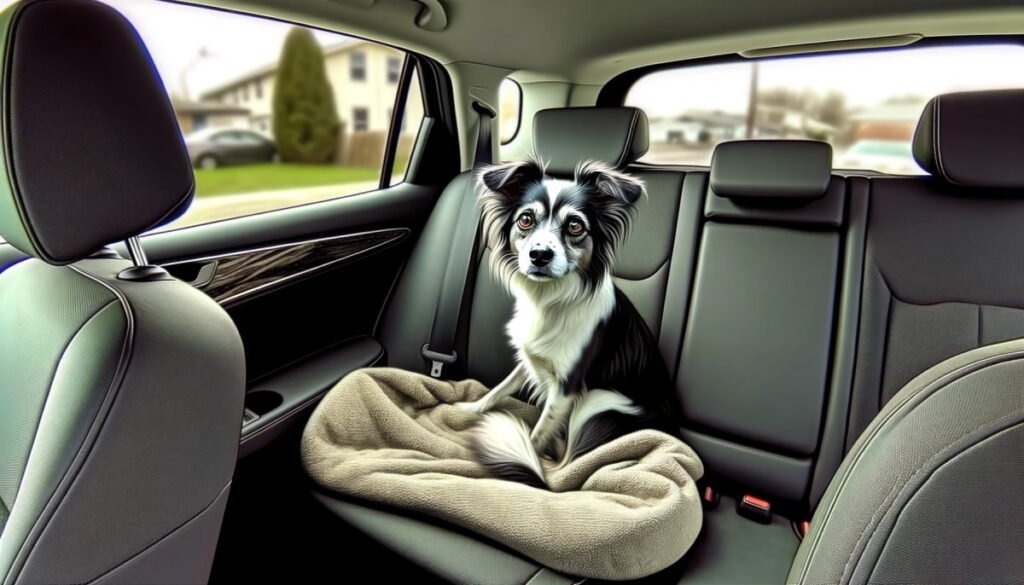Visiting Canada with a Dog: Essential Traveling Tips
Visiting Canada with a dog promises an adventure filled with stunning landscapes and welcoming communities, perfect for exploring with your furry friend by your side.
Whether you’re setting out to explore the vast Canadian wilderness, immerse yourself in vibrant city scenes, or check out a multitude of attractions, this guide is your go-to resource for pet travel.
It’s packed with essential tips, covering everything from legal border requirements to practical travel advices, all aimed at ensuring a seamless and delightful experience for you and your dog.

Visiting Canada With a Dog: Understand the Key Requirements
When you’re heading to Canada with your dog, there are some important bits and legal requirements you’ll need to take care of to ensure a smooth border crossing. Here’s a friendly rundown of what you need to know:
Dogs are Subject to a Visual Inspection: Upon arrival in Canada, your dog will undergo a visual inspection by the Canada Border Services Agency (CBSA) officers. Officers will be looking for signs of illness, distress, or mistreatment. If the officer has concerns about the health of your dog or its documentation, they may require a more thorough examination by a quarantine officer, which could involve additional fees.
Rabies Vaccination: This is crucial. Canada requires that any dog over the age of three months coming into the country have a current rabies vaccination. If your furry companion is younger than three months old, they are generally exempt from the rabies vaccination requirement to enter Canada. Make sure to bring along proof of the vaccination, which should include the vaccine’s name, the date it was given, and its validity period. This proof needs to be in English or French, or a certified translation should be provided.
Health Certificate: While not always required, it’s advisable to have a recent health certificate from your vet, stating that your dog is healthy and fit for travel. This can smooth things over and help avoid any potential hiccups at the border.
Identification: Ensure your dog has a clearly readable ID tag with your name and contact information on it. In Canada, microchipping and tattooing are not required but are highly recommended for extra safety, as they can help reunite you quickly if you get separated.
Quarantine: Quarantine is usually not required for dogs entering Canada if they have a valid rabies vaccination and meet the entry requirements. However, dogs suspected of carrying diseases or coming from countries not recognized as rabies-free by Canada might face quarantine or stricter rules. It’s important to check the latest guidelines from the Canadian Food Inspection Agency (CFIA) before your trip.
Traveling to Canada with a Service Dog
Traveling to Canada with a service dog is designed to be as smooth and stress-free as possible for both you and your companion.
Canada recognizes the vital role of service dogs, allowing them to accompany their owners in nearly all public spaces, including transportation and various accommodations. To facilitate this process, it’s essential to have proper identification and documentation for your service or assistance dog.
Such documentation may include certification from a recognized training organization, identification cards, or proof of the dog’s status as a service animal.
Like any other dog entering Canada, service and assistance dogs must also have up-to-date rabies vaccinations. You should carry the vaccination certificate with you, which clearly indicates the vaccine’s name, the date it was administered, and the duration of its effectiveness.
Although a health certificate may not always be mandatory for service and assistance dogs, possessing one can be beneficial. It helps to demonstrate that your dog is fit for travel and free from any contagious diseases, ensuring a smooth entry into Canada and a pleasant stay.
Road Tripping to Canada with a Dog

Driving across Canada with your dog can be an enjoyable experience for both of you, with a bit of preparation. Here are some tips to ensure a smooth journey:
- Secure Your Dog: Use a pet seatbelt, carrier, or vehicle pet barrier to keep your dog safe and prevent distractions while you drive.
- Plan for Breaks: Dogs need regular stops for bathroom breaks and to stretch their legs. Plan your route to include stops every 2-3 hours at pet-friendly rest areas or parks.
- Keep Your Dog Hydrated: Bring along a portable water bowl and plenty of fresh water to ensure your dog stays hydrated, especially on long drives or during hot weather.
- Never Leave Your Dog Alone in the Car: Cars can heat up quickly, even on cool days, posing a significant risk to your dog. Always take your dog with you when you leave the vehicle.
- Bring Familiar Items: To help your dog feel more comfortable and reduce anxiety, bring along their favorite toys, a blanket, or a bed from home.
- Accident Readiness: Despite your best efforts, accidents can happen. Pack a small travel kit with poop bags, cleaning supplies, such as paper towels, disinfectant wipes, and a portable spray cleaner. This will help you quickly manage any unexpected messes.
- Update Identification: Make sure your dog’s collar has an ID tag with your current contact information, and consider microchipping as an added precaution.
- Carry a Pet First-Aid Kit: Have a basic first-aid kit for your dog in case of emergencies.
- Research Pet-Friendly Accommodations: If your journey spans several days, ensure you’ve booked pet-friendly hotels or campsites in advance.
- Follow Local Laws: Be aware of and comply with local leash laws and pet regulations in the places you’re visiting.
- Prepare for the Weather: Canada’s weather can vary greatly, so bring appropriate gear for your dog, whether it’s a coat for cold weather or a cooling mat for the heat.
A Dog-Friendly Guide to Air Travel
Traveling to Canada by air with your dog involves understanding the different options for your pet’s journey: in the cabin, as checked baggage, or in the cargo hold. Each option has its guidelines to ensure a safe and comfortable trip for your furry friend.
Your Pet in the Cabin
Most airlines permit small dogs to join their owners in the cabin, provided they stay in a carrier that fits under the seat. Remember, there’s typically a fee for this convenience, and spots must be reserved in advance due to limited availability. The carrier itself should be secure and well-ventilated, ensuring your dog can stand, turn around, and lie down with ease for a comfortable journey.
Your Dog in the Baggage Compartment
For medium to large dogs that can’t fit in the cabin, flying in the pressurized baggage compartment is an option. Just like cabin travel, booking in advance and paying a fee are necessary, and you should verify the airline’s restrictions on size and weight. Ensure the kennel is IATA-approved, secure, and has ample ventilation, providing enough space for your dog to be comfortable during the flight.
Cargo Travel
If your dog is very large or belongs to a breed with size or travel restrictions, cargo travel may be necessary. This process usually involves making a separate booking through the airline’s cargo department. It’s vital to make sure your dog is fit for air travel, particularly for breeds with potential respiratory problems. Although the cargo hold is pressurized and temperature controlled, always prioritize your pet’s health and safety by considering their specific needs throughout the journey.
Restricted Dog Breeds in Ontario, Canada
Canada does not have a federal ban on specific dog breeds entering the country. However, it’s important to note that certain provinces or municipalities within Canada may have their own regulations or bans on specific breeds.
For example, Ontario has restrictions on pit bulls, including the American Pit Bull Terrier, American Staffordshire Terrier, Staffordshire Bull Terrier, and any dog that resembles these breeds. Other regions may have their own restrictions or requirements, so it’s crucial to research the specific laws of the province or city you plan to visit with your dog to ensure compliance and avoid any issues during your stay.
Bringing Dog Food into Canada: Basic Rules and Regulations
When bringing dog food into Canada, remember these key points:
- Quantity: You can bring up to 20 kg (about 44 lbs) of commercially packaged dog food.
- Packaging: The food must be in its original packaging, showing ingredients and country of origin.
- Use: It should be for the dog traveling with you.
- Declaration: Declare the dog food at the border.
- Check Restrictions: Certain ingredients like beef or lamb may have extra rules, so it’s wise to quickly check the latest on the Canadian Food Inspection Agency’s website before you travel.
Potential Issues at the Border: Navigating Challenges with Your Dog
When crossing the border into Canada with a dog, several issues can arise that could complicate your entry. The Canada Border Services Agency (CBSA) officers play a crucial role in this process, and they have the authority to refuse entry, confiscate, or detain an animal under certain conditions. Here are potential complications you might face:
Undeclared Animals: Failing to declare your dog, including family pets, upon arrival can lead to refusal of entry for your pet. Always make sure to declare your dog to CBSA officers to avoid any complications.
Lack of Necessary Documentation: If you do not have the required permits or health certificates, such as proof of rabies vaccination, your dog could be denied entry into Canada. It’s essential to carry and present all necessary documentation upon request.
Health Concerns: If your dog is suspected of being sick or infected with a pest or disease, CBSA officers have the authority to refuse its entry. This is to prevent the spread of diseases within Canada.
Inhumane Transportation: Dogs that are transported in conditions deemed non-humane, where they are not kept safe from harm and injury, can lead to the pet being confiscated or detained. It’s crucial to ensure that your dog is transported in a comfortable, secure, and humane manner, adhering to the transportation guidelines provided by the airline or transport service.
To avoid these potential issues, preparation is key. Ensure your dog is declared upon arrival, carry all necessary documentation, confirm your dog is in good health, and transport your dog in a humane and secure manner.
Taking these steps can help ensure a smooth crossing into Canada with your dog.
Related Articles
-

Ultimate Visitor’s Guide to Things to Do in Ottawa, Ontario
Looking for attractions and exciting things to do in Ottawa, Ontario? As Canada’s capital, Ottawa blends rich history, cultural landmarks,… Read more
-

Best of Canada: Things to Do in Toronto, Ontario
So, what can you do in Toronto, Ontario? What are the most popular attractions and activities in this bustling, multicultural… Read more
-

Exploring Stratford: Popular Things to Do in Stratford, Ontario
So, what can you do in Stratford, Ontario? What are the most popular attractions and top things to see in… Read more







